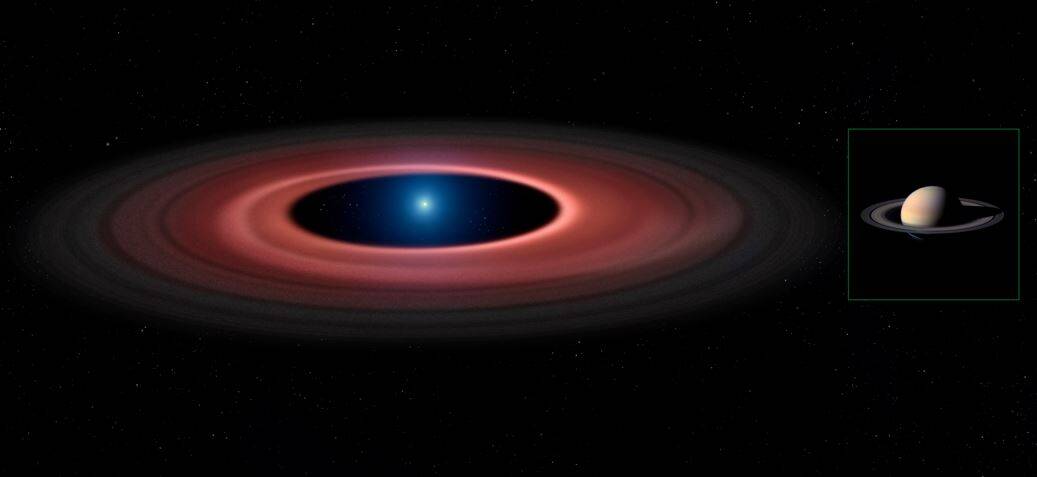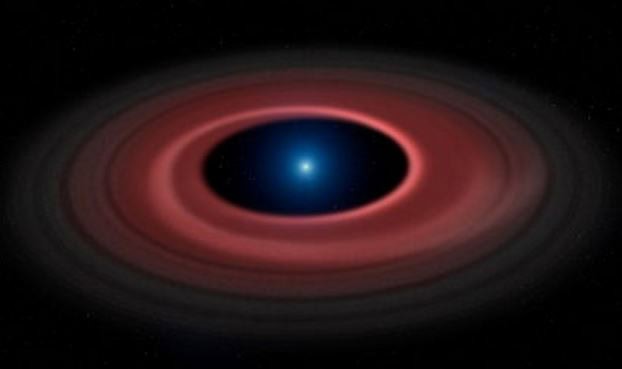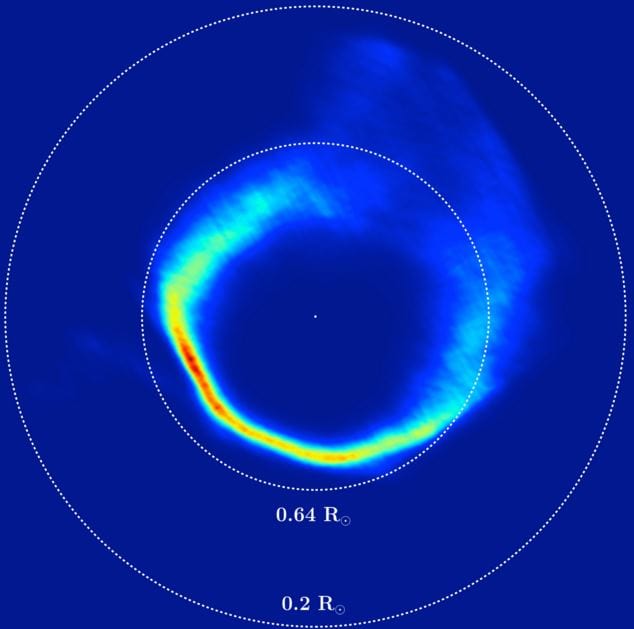An asteroid being ripped to shreds by a dead star (white dwarf) and forming a ring of dust and glowing debris around it has been photographed by astrophysicists at the University of Warwick’s Astrophysics Group. They say their image is a world first.
A white dwarf is a star that has exhausted all its central nuclear fuel and lost its outer layers. It is a very dense star, usually about the size of a planet (but with a gravitational pull many thousands of times greater).
The rings, which comprise debris and dust particles, were formed by the strong gravitational pull of the white dwarf grabbing unfortunate asteroids as they came too close.
 The disc around SDSS1228+1040 in scale to Saturn and its rings. Even though the dead star is seven times smaller than Saturn, it weighs at least 2,500 more. (Credit: Mark Garlick/University of Warwick)
The disc around SDSS1228+1040 in scale to Saturn and its rings. Even though the dead star is seven times smaller than Saturn, it weighs at least 2,500 more. (Credit: Mark Garlick/University of Warwick)
As the bits of debris crashed into each other in the ring, gas was released, which was lit up by ultraviolet rays from the star, causing it to give off a dark, red glow which the team was able to observe, and turned into the image of the ring.
PhD student Christopher Manser, the study leader, and colleagues studied what remained of the planetary system around SDSS1228+1040 (the white dwarf star’s name).
A giant version of Saturn’s rings
The rings around this white dwarf are similar to those that surround Saturn, but much, much bigger.
Mr. Manser said:
“The diameter of the gap inside of the debris ring is 700,000 kilometres, approximately half the size of the Sun and the same space could fit both Saturn and its rings, which are only around 270,000 km across.”
“At the same time, the white dwarf is seven times smaller than Saturn but weighs 2500 times more.”
Scientists have detected rings around several other stars in the past. But nobody has produced an image like this one, the researchers claim. It provides an unprecedented insight into the structure of these systems.
Mr. Manser explained:
“We knew about these debris disks around white dwarfs for over twenty years, but have only now been able to obtain the first image of one of these disks.”
 The white dwarf surrounded by a ring comprising dust particles and debris from an asteroid ripped apart by its strong gravity. (Credit: Mark Garlick/University of Warwick)
The white dwarf surrounded by a ring comprising dust particles and debris from an asteroid ripped apart by its strong gravity. (Credit: Mark Garlick/University of Warwick)
Doppler Tomography used to create the image
Manser and colleagues used a technology similar to CT (Computed Tomography) scanning used in hospitals, called Doppler Tomography. Images are taken from many different angles. They are all then put together in a computer, which creates a much more detailed picture.
While a hospital’s CT device moves around the patient as it takes pictures, with Doppler Photography, the target object moves. The rings around the dead star rotate very slowly, so several images were taken over a 12-year period.
Regarding what the team saw in the image, Mr. Manser said:
“The image we get from the processed data shows us that these systems are truly disc-like, and reveal many structures that we cannot detect in a single snapshot. The image shows a spiral-like structure which we think is related to collisions between dust grains in the debris disc.”
 After taking pictures over a period of 12 years of the debris disk around SDSS1228+1040. With Doppler Tomography, the image has an inside-out structure – the gas closest to the white dwarf appears further away. The figures 0.2 and 0.64 are proportions to our Sun’s radius. (Image: University of Warwick)
After taking pictures over a period of 12 years of the debris disk around SDSS1228+1040. With Doppler Tomography, the image has an inside-out structure – the gas closest to the white dwarf appears further away. The figures 0.2 and 0.64 are proportions to our Sun’s radius. (Image: University of Warwick)
A glimpse of our own fate when the Sun dies
By studying what happened with SDSS1228+1040, we have a glimpse of our own Solar System’s future as soon as the Sun loses its fuel and starts dying.
By gathering and analyzing data on these systems, scientists will be closer to answering several questions, such as whether other planetary systems like ours exist, and what might eventually occur in our own Solar System.
Professor Boris Gänsicke, who works at the University of Warwick’s Astrophysics Group, said:
“When we discovered this debris disk orbiting the white dwarf SDSS1228+1040 back in 2006, we thought we saw some signs of an asymmetric shape. However, we could not have imagined the exquisite details that are now visible in this image constructed from twelve years of data – it was definitely worth the wait.”
“Over the past decade, we have learned that remnants of planetary systems around white dwarfs are ubiquitous, and over thirty debris disks have been found by now. While most of them are in a stable state, just like Saturn’s rings, a handful are seen to change, and it is those systems that can tell us something about how these rings are formed.”
Video – Dead star tears asteroid to shreds
